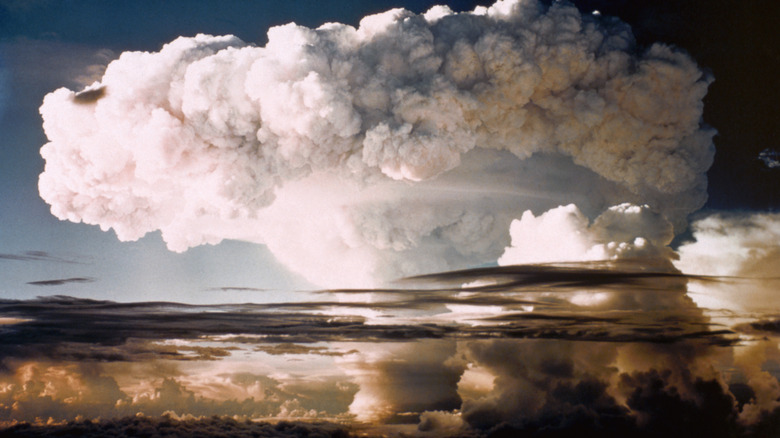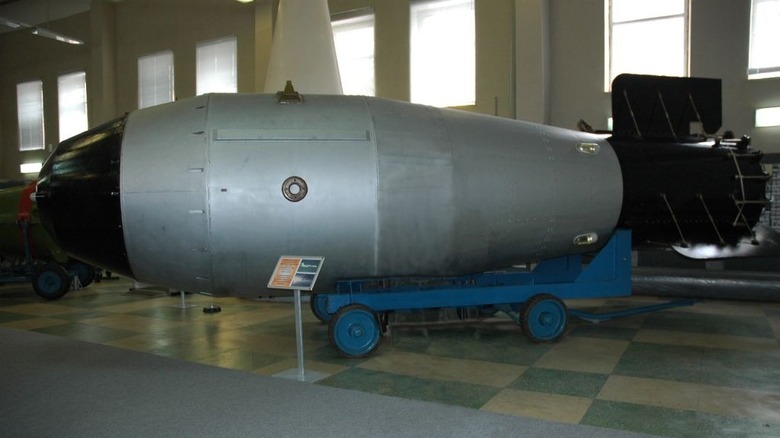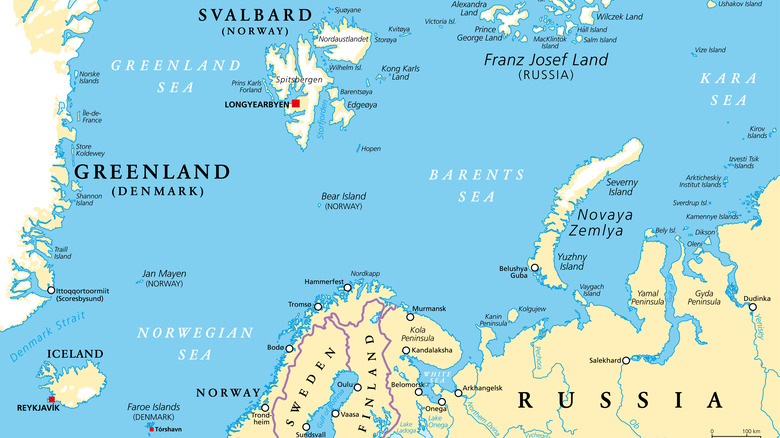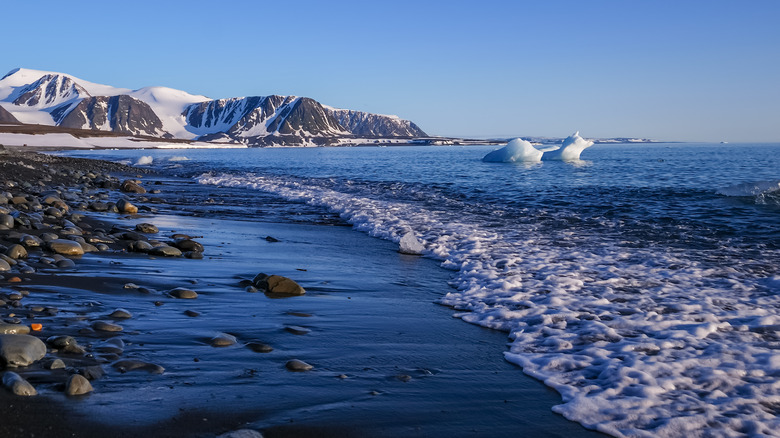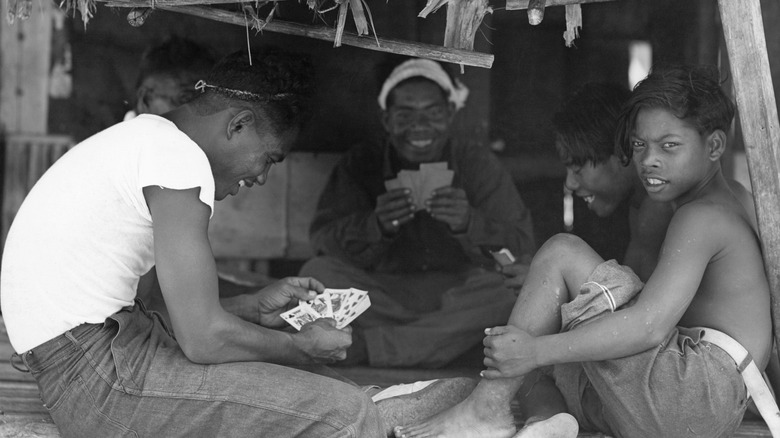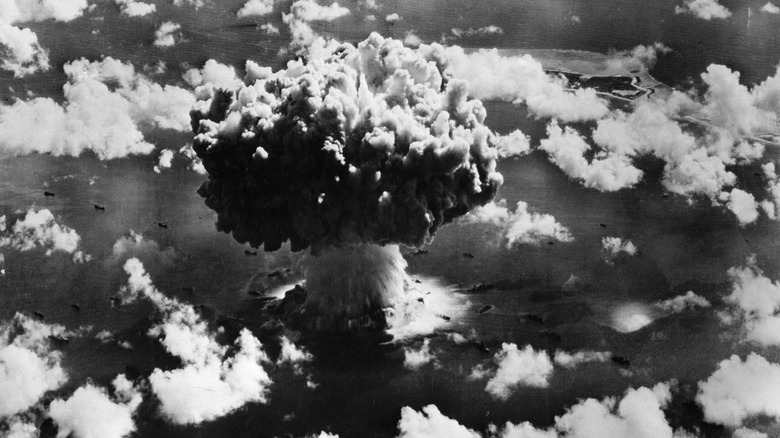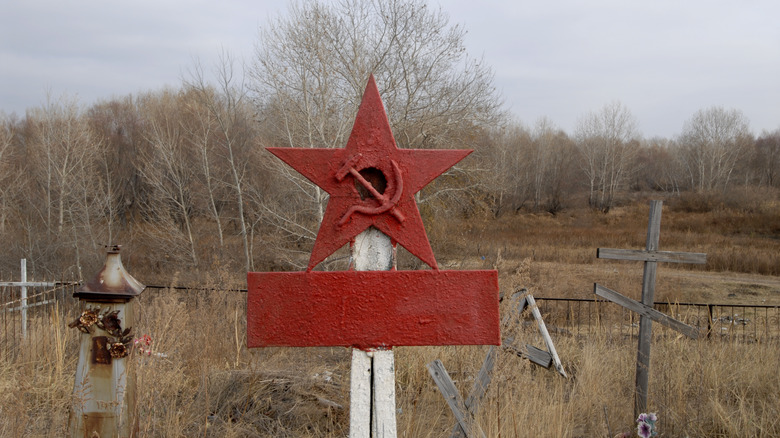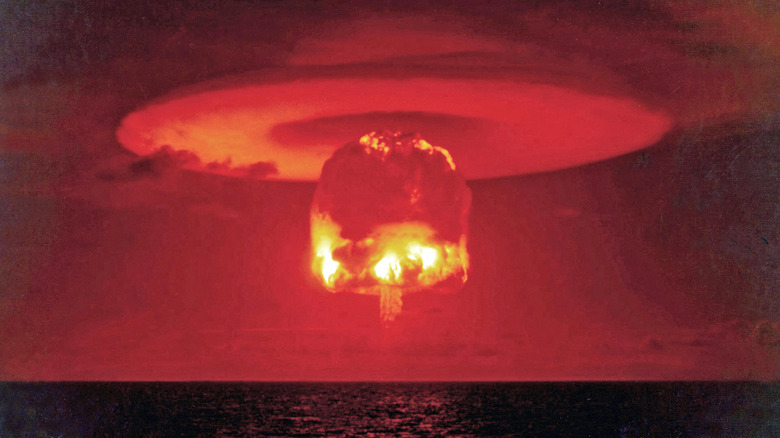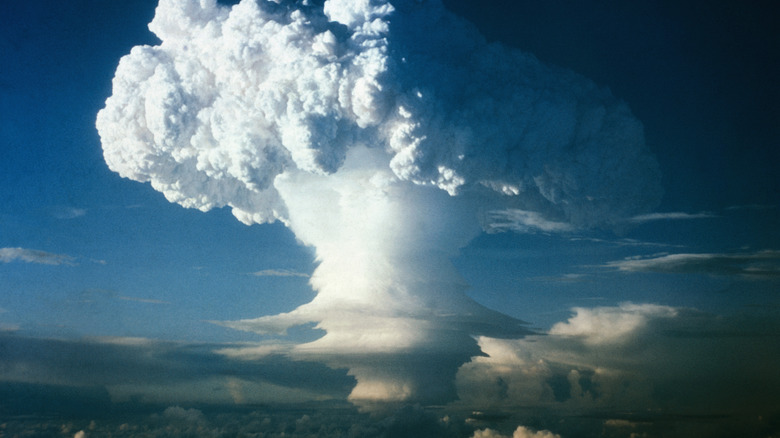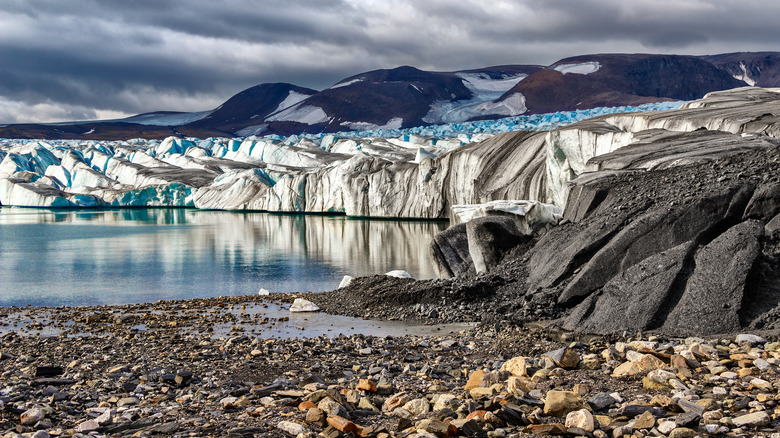10 Of The Most Powerful Nuclear Bombs Ever Detonated
Humans have yet to develop a more powerful and devastating weapon than the nuclear bomb. The largest bombs are capable of not only razing entire cities to the ground but also releasing extreme levels of radiation that will continue to contaminate Earth and its inhabitants for many years after the explosion occurs, with the full effects only recently beginning to be understood by scientists. J. Robert Oppenheimer is considered to be the "father of the atomic bomb," heading the lab working on the Manhattan Project and ultimately responsible for the development of the first working examples. However, it was in the late '50s and early '60s that the first very high-yield weapons began to be tested, with the U.S. and the Soviet Union facing off against each other for military supremacy in a show of Cold War posturing.
Ultimately, the development of these so-called "superbombs" ended with the 1963 Limited Test Ban Treaty, but the threat of nuclear warfare is still very much present today. In fact, the Bulletin of the Atomic Scientists announced it would move its "Doomsday Clock" to 90 seconds to midnight in January 2023, reflecting the fact that, in the view of the world's leading nuclear experts, a global nuclear catastrophe is now closer than ever before. Thankfully, however, it seems the days of very high-yield bombs are now in the past, and we can all hope that no new entries are ever needed to the list of the most powerful nuclear bombs ever detonated.
Tsar Bomba - 50 megatons
The Tsar Bomba, roughly translated as "Emperor Bomb," is by far the most powerful nuclear bomb detonated to date. It exploded with a force of 50 megatons, although it was originally designed to yield double that figure, according to the Bulletin of the Atomic Scientists. The bomb was constructed by Soviet scientists at the request of Nikita Khrushchev, the country's leader at the time, and was detonated at the end of October 1961. This came just a few months after Khrushchev had reneged on the Test Ban Moratorium of 1958, where the Soviet and U.S. forces had both agreed to halt nuclear testing.
The bomb was detonated above the remote archipelago of Novaya Zemlya, a region north of the mainland in the Arctic Circle. It was dropped with a parachute in an attempt to give the bomber pilots enough time to escape the blast, although initial estimates from scientists put their survival chances around 50%. While they did survive, the islands below were obliterated, with a village 34 miles away from ground zero seeing every building destroyed. Damage was reported to buildings 100 miles away, and the mushroom cloud caused by the bomb stretched a reported 40 miles into the sky. The detonation was met with global outcry, although testing of very high-yield bombs by the Soviets continued for another two years until the Limited Test Ban Treaty was enacted.
[Featured image by Croquant via Wikimedia Commons | Cropped and scaled | CC BY-SA 3.0]
Test 219 - 24.2 megatons
Although the Tsar Bomba is recognized as the most devastating nuclear bomb ever tested, a number of other Soviet bombs developed around the same time also eclipsed anything the U.S. ever detonated. A lot less is known about these tests, most of which are only referred to in documents by their respective test numbers in the development program. A 1996 paper compiled by the Natural Resources Defense Council shows the most powerful of these tests to be Test 219, which recorded a force of 24.2 megatons. That's equivalent to the explosive power of 24.2 million tons of TNT.
This test took place on Christmas Eve 1962, again over the Arctic wilderness of Novaya Zemlya. It would turn out to be one of the last airborne detonations to take place before the practice was outlawed in 1963. It was followed up by a 3.1-megaton bomb detonated on Christmas Day, alongside a much smaller 8-kiloton bomb. This marked the very last of the Soviet air detonations, with all further tests taking place underground, where explosions could be more safely contained.
Test 147 - 21.1 megatons
The third most powerful test took place earlier in 1962, with a yield of 21.1 megatons. Much like the other very high-yield Soviet bomb tests, Test 147 was detonated in the air over Novaya Zemlya, and was followed up by several smaller bombs over the following days and weeks. Much of the test reports surrounding these bombs remain classified or inaccessible, making it tricky to establish exactly what purpose each high-yield bomb detonation served.
This information was of great interest to the American defense forces at the time, too, but it's unclear how much they were able to find out about the testing program. One of the key ways the U.S. gained information about how much plutonium was being produced for Soviet nuclear bombs was by covert air testing operations. The plutonium manufacturing process releases the isotope Krypton-85 into the atmosphere, and by calculating the amount of isotope present in an air sample, American forces could work out how much plutonium was being produced. It couldn't, however, predict when or where the plutonium in question might be used, which was arguably the greatest concern to the Americans given the rapid Soviet development of these supersized atomic bombs.
Test 173 - 19.1 megatons
Conducted on the 25th of September 1962, Test 173 saw the detonation of a bomb yielding 19.1 megatons, again over Novaya Zemlya. It's worth noting that, before testing began, the islands themselves had a small but permanent population, comprising mostly of indigenous Nenet families. Originally nomadic, the Nenet population had been resettled from the mainland to live on Novaya Zemlya in 1887, under the leadership of European Russian colonialist, Konstantin Nosilov. This was mainly for political purposes: Norwegian hunters and fishermen had previously frequented the islands and the Russian authorities wanted to ensure that they remained in control of the territory.
For decades after, Novaya Zemlya remained home to the settlers, with a strong community built up by the 1920s, including nationally renowned painter Tyko Vylka, who was born on the islands. With the commencement of nuclear testing in the region in 1955, this community was all but erased as its members were forcibly relocated for their own safety. By the time Test 173 was detonated, the area had become so contaminated with nuclear material that a return to its previous status as a rich fishing and hunting ground had become unthinkable.
Castle Bravo - 15 megatons
While the Soviets were by far the most prolific builders of very high-yield atomic bombs, the U.S. efforts during the same era also produced plenty of alarmingly powerful weapons. The largest of those to be detonated was Castle Bravo, although it wasn't designed to be anywhere near as powerful as it turned out to be. Detonated on March 1st, 1954, it was the first bomb constructed with "dry" isotope, and predictions for its power ranged between five and six megatons. However, upon detonation it proved to be much more powerful, generating 15 megatons. The unexpected power of the bomb turned out to have far-reaching consequences, including exposing residents of the Marshall Islands, where it was tested, to intense radiation.
Studies have shown that the Castle Bravo bomb was responsible for the majority of radiation poisoning the islanders suffered, even though many other bombs were also detonated there over the American testing program. This caused an increased rate of cancer and birth defects among the exposed, with the effects still being documented to this day. A Japanese fishing boat was also caught up in the fallout, causing a diplomatic incident between the two countries. Despite the international backlash, the incident didn't deter U.S. defense chiefs, who would continue atmospheric tests for nearly a decade after the Castle Bravo test.
Castle Yankee - 13.5 megatons
The second most powerful atomic bomb detonation in U.S. history — and the sixth most powerful in the world — was the Castle Yankee bomb, part of the same series of tests as Castle Bravo. Conducted on May 14th, 1954, Yankee produced a considerably higher yield than it was predicted to, much like Bravo. It was predicted to yield around 9.5 megatons but was in fact measured at 13.5 megatons. The cloud generated by the bomb stretched up 25 miles into the air — for reference, that's almost five times the height of Mount Everest.
The circumference of the cloud was said to measure more than 100 miles wide at its largest point, with debris shooting high into the stratosphere. It was to be the last of the detonation tests performed on Bikini Atoll in the Marshall Islands that year, although a further 16 bombs would be detonated on the atoll before atmospheric testing was banned.
Test 123 - 12.5 megatons
The 12.5-megaton nuclear bomb detonated on 23rd October 1961 marked a milestone for the Soviet nuclear program. Test 123 was the first time the Soviets had successfully deployed a bomb over 10 megatons. It was a considerable leap over their previous record, too: Just a few weeks before on the 6th of October, Test 114 had set a new confirmed record explosion of four megatons. Like all of the Union's most powerful bombs, it was detonated over Novaya Zemlya, even though multiple other test sites were also in use for less powerful devices at the time.
The 1961 testing program saw a number of firsts, with the Soviets developing new, more advanced weaponry at a remarkable rate. Just four days after the conclusion of Test 123, the program launched its first nuclear detonation in space, and less than a week later, the unprecedented force that was the Tsar Bomba was unveiled to an anxious global reception.
Castle Romeo - 11 megatons
After the international outcry caused by the miscalculation of Castle Bravo's yield, program chiefs were keen to ensure the second Castle test, Romeo, went without a hitch. The detonation date was originally set for March 13th, less than two weeks after Bravo, but bad weather delayed the test. After two weeks of canceled tests, plans were made to transfer the bomb to Enewetak Atoll, another atoll in the Marshall Islands, but just before the transfer was set to begin, the weather improved and the decision was made to keep it in place.
Rather than being dropped from the air like many high-yield bombs, Romeo was detonated on a barge at sea level, which was stationed in the center of the crater left by Bravo. It yielded 11 megatons, making it the second most powerful bomb ever detonated up until that point. Its success encouraged the U.S. to continue with its high-yield testing program, despite certain high-ranking figures in government calling for a ban on such tests amid concerns about global repercussions if other nations (in particular, the Soviets) tried to match its power. No such ban emerged, and testing from both sides continued, although it would only be the Soviets that eventually detonated larger-scale bombs in the following years.
Ivy Mike - 10.4 megatons
Ivy Mike, sometimes referred to as simply "Mike," was the first fusion bomb detonated by the U.S., yielding 10.4 megatons. It was detonated on an island in Enewetak Atoll in the Marshall Islands, with the explosion so powerful that it destroyed the island entirely, leaving a large crater in its place. The crater was reportedly more than 160 feet deep and 2,600 feet wide, with a mushroom cloud billowing from the scene of the destruction.
Despite the groundbreaking nature of the test, it was initially kept secret by the government, although before long, press reports began to emerge of a mysterious and extremely powerful new type of bomb. President Truman had little choice but to officially confirm its existence, announcing the successful test on January 7th, 1953. Although it proved the technology behind this type of bomb was feasible, Ivy Mike itself was not capable of being used for military purposes — it was a huge, impractical device that was suitable for experimental use only. Nonetheless, it gave the American government the encouragement to develop the program further to produce usable high-yield nuclear weapons over the following years.
Test 174 - 10 megatons
One of the most obscure Soviet nuclear tests, Test 174's yield is listed only as "more than 10,000 [kilotons]". It was detonated just two days after Test 173, the fourth most powerful nuclear bomb explosion, over the same Novaya Zemlya testing site. With so many tests conducted there, the site is still, unsurprisingly, highly contaminated today. However, a recent study published in the Scientific Reports journal showed that contamination might be present in more ways than originally thought: alongside the fallout immediately generated after the detonation of the bombs, the ice sheet covering much of the islands may also have become contaminated.
As the ice begins to melt at an increasingly rapid rate due to climate change, contaminated water may continue to spill out into the surrounding area, and very little is known at present as to what further environmental damage this might cause. It seems increasingly certain, then, that even if no other nuclear bombs are ever detonated, the damage caused by the biggest bombs of the '50s and '60s will continue to affect the environment, and by extension, the population, long into the future.
